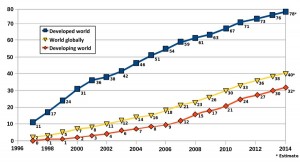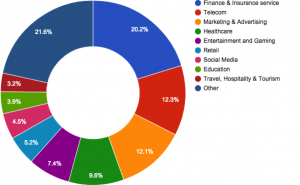Amazon has been having huge success over the past years, and it doesn’t seem like it’s going to stop anytime soon. According to an analysis by Slice Intelligence, 43% of all online retail sales in the U.S. went through Amazon in 2016. This is a huge increase from the 25% of eCommerce sales Amazon was reported to have captured back in 2012. With such an astounding increase in market share, what does the future hold for Amazon sellers? Can we expect this success to continue indefinitely?
It certainly looks like it is not slowing down. The giant is up to date with the latest trends, such as voice assistant technology, thanks to Alexa. It has also made major moves to expand its market share beyond its current offering by recently acquiring Whole Foods and shaking up the grocery industry.
However, there are other giants like Walmart that are not willing to give up, catching up with Amazon’s offers, such as their famous 2-day free shipping. Walmart even goes as far as to offer it without a subscription requirement! Also, Amazon’s one-click buying patent expired this year, which gives more room for competitors to strengthen their offerings. Let’s discover what else we can expect from selling on Amazon and how to prepare for any changes.
FBA: An Option or a Must for Retailers?
As many online retailers may have picked up, FBA is becoming a must to be competitive on Amazon. First, it allows sellers to offer their products with 2-day free shipping to Amazon Prime members. This is key, considering that Prime memberships are multiplying every year. So much so that, according to a survey by Cowen & Co., 53% of all Amazon purchases came from Prime members in 2016. The reason? Everyone loves fast and free shipping.
Additionally, using fulfillment by Amazon or FBA helps retailers win the desired Buy Box. Since Amazon handles the fulfillment, it gives the marketplace higher control over customer service and, thus, more certainty that the customer will be satisfied—therefore, giving preference to those sellers using FBA.
Also, keep in mind that the increase in orders through voice assistants like Alexa will make the Buy Box even more important and competitive. Amazon will only suggest retailers with the top spots! In addition to this, Alexa has its own kind of deals called Alexa Deals, which are already showing a preference toward Prime sellers. Considering all of these factors, I believe most retailers will be forced to become FBA sellers.
Forget About Non-GS1 Codes
All Amazon sellers need a UPC or ASIN code to sell on Amazon. The GS1 is the official seller of such barcodes. However, many sellers prefer to buy barcodes from resellers, instead of buying them through the GS1 site, because the codes are considerably less expensive. The GS1 charges a fee to create a company prefix, which ranges from $ 250 to upward of $ 10,000, plus renewal fees. The cost can get really expensive as the number of products increases.
The issue is that codes sold by resellers have prefixes that belong to other companies. When scanned, those codes can confuse the Amazon system and pass by another company’s name. That’s why Amazon has been suspending accounts using resold barcodes. Last year, Amazon announced the following:
“We verify the authenticity of product UPCs by checking the GS1 database. UPCs that do not match the information provided by GS1 will be considered invalid. We recommend obtaining your UPCs directly from GS1 (and not from other third parties selling UPC licenses) to ensure the appropriate information is reflected in the GS1 database.”
An increasing amount of seller accounts have been affected, and we expect this number to continue to increase in the future. Pad your budgets accordingly to make any necessary adjustments in the near future.
Increased Tendency Toward Pay to Play
As Amazon becomes increasingly popular, the competition is also becoming increasingly fierce. This is pushing many sellers to use Amazon advertising—mostly sponsored ads—to rise above the competition. Also, the fact that Amazon has ended incentivized reviews leaves many sellers at a disadvantage against other sellers that are lucky enough to get into the Vine program—therefore encouraging those sellers to start advertising.
In the past, retailers were able to offer discounted or free products in exchange for reviews (incentivized reviews) as long as such exchange was disclosed. Now, only Amazon can incentivize customers to give reviews with their Vine program. With Vine, Amazon, not the seller, invites customers to post reviews to specifically chosen sellers. As the Amazon VP of customer service stated:
“In just the past year, we’ve improved review ratings by introducing a machine-learned algorithm that gives more weight to newer, more helpful reviews; applying stricter criteria to qualify for the Amazon verified purchase badge; and suspending, banning or suing thousands of individuals for attempting to manipulate reviews … we updated the community guidelines to prohibit incentivized reviews unless they are facilitated through the Amazon Vine program.”
This system provides Amazon more control over reviews, but it also puts many sellers at a disadvantage. As we mentioned above, we expect this change to drive the use of sponsored ads in the near future.
Final Notes
As is true with many other online platforms, Amazon is ever-evolving. It has transformed into one of the main drivers of eCommerce sales online, and it doesn’t look like it’s stopping anytime soon. It’s already taking over the grocery world and voice assistant technologies, and who knows what will be next? For the foreseen future, Amazon sellers can expect a higher preference for Prime sellers, more strict sanctions against non-GS1 codes, and an increased tendency toward “pay to play.” Plan accordingly to stay on top of the competition!
Digital & Social Articles on Business 2 Community(54)
Report Post






